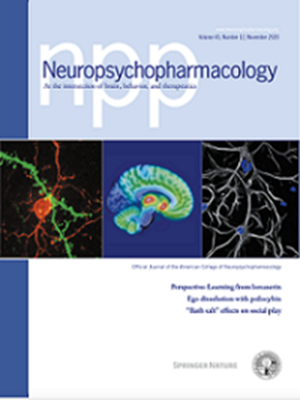妊娠期神经活性类固醇生物合成预测未来的产后抑郁症:3α和/或3β-HSD神经类固醇生成酶的作用?
IF 6.6
1区 医学
Q1 NEUROSCIENCES
引用次数: 0
摘要
产后抑郁症(PPD)影响约10-15%的育龄个体,并对两代人产生有害影响。最近的研究探索了PPD的生物学机制,特别是神经活性类固醇(NAS)。我们在此试图调查怀孕期间NAS水平和比值与产后抑郁症状的后续发展之间的关系。在怀孕和产后的8次访问中,对有和没有情绪障碍的个体进行了NAS水平和心理量表的测量。使用广义线性混合效应回归模型来评估健康妊娠个体中每个NAS生物标志物和比率与随后PPD之间的关系。在妊娠晚期(T3),异异体孕酮/孕酮比值增加1个单位的参与者患PPD的几率较高(OR = 1.64, 95% CI: 1.13-2.37,经FDR校正p = 0.038, C-index = 0.82),而孕酮/孕酮比值增加1个单位的参与者患PPD的几率较低(OR = 0.64, 95% CI: 0.47-0.88,经FDR校正p = 0.036, C-index = 0.82);T3时孕酮水平升高1个单位的患者发生PPD的几率更高(OR = 4.00, 95% CI: 1.54 ~ 10.37,经FDR调整p = 0.035, C-index = 0.80)。我们发现孕晚期孕酮代谢途径的关键差异,表明3α-HSD酶的活性/表达可能降低和/或3β-HSD的活性/表达增加。本文章由计算机程序翻译,如有差异,请以英文原文为准。

Neuroactive steroid biosynthesis during pregnancy predicts future postpartum depression: a role for the 3α and/or 3β-HSD neurosteroidogenic enzymes?
Postpartum depression (PPD) affects ~10–15% of childbearing individuals, with deleterious consequences for two generations. Recent research has explored the biological mechanisms of PPD, particularly neuroactive steroids (NAS). We sought here to investigate associations between NAS levels and ratios during pregnancy and the subsequent development of depressive symptoms with postpartum onset. NAS levels and psychological scales were measured in individuals with and without mood disorders at up to eight visits across pregnancy and postpartum. Generalized linear mixed-effects regression models were used to assess relationships in euthymic pregnant individuals between each of the NAS biomarkers and ratios and subsequent PPD. Participants with a one-unit increase in the log isoallopregnanolone/pregnanolone ratio at the third trimester (T3) had higher odds (OR = 1.64, 95% CI: 1.13–2.37, FDR adjusted p = 0.038, C-index = 0.82), and those with a one-unit increase in the log pregnanolone/progesterone ratio at T3 had lower odds (OR = 0.64, 95% CI: 0.47–0.88, FDR adjusted p = 0.036, C-index = 0.82) of developing PPD; those with a one-unit increase in the log progesterone level at T3 had higher odds of developing PPD (OR = 4.00, 95% CI: 1.54–10.37, FDR adjusted p = 0.035, C-index = 0.80). We found key differences in the progesterone metabolic pathway at the third trimester, indicating likely decreased activity/expression of the 3α-HSD enzyme and/or increased activity/expression of 3β-HSD.
求助全文
通过发布文献求助,成功后即可免费获取论文全文。
去求助
来源期刊

Neuropsychopharmacology
医学-精神病学
CiteScore
15.00
自引率
2.60%
发文量
240
审稿时长
2 months
期刊介绍:
Neuropsychopharmacology is a reputable international scientific journal that serves as the official publication of the American College of Neuropsychopharmacology (ACNP). The journal's primary focus is on research that enhances our knowledge of the brain and behavior, with a particular emphasis on the molecular, cellular, physiological, and psychological aspects of substances that affect the central nervous system (CNS). It also aims to identify new molecular targets for the development of future drugs.
The journal prioritizes original research reports, but it also welcomes mini-reviews and perspectives, which are often solicited by the editorial office. These types of articles provide valuable insights and syntheses of current research trends and future directions in the field of neuroscience and pharmacology.
 求助内容:
求助内容: 应助结果提醒方式:
应助结果提醒方式:


